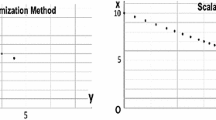Abstract
In this paper we offer a statement of the continuous multiobjective equilibrium network design problem and discuss how it may be solved by an adaptation of Geoffrion’s interactive method. The formulation is fully multimodal and employs no symmetry restrictions.
The equilibrium network design problem is concerned with selecting those link additions or improvements which minimize system-wide costs subject to flow conservation constraints and a budget constraint, together with the requirement that the flow pattern be in accord with Wardrop’s first principle or user optimization rule. This problem may be formulated with either discrete or continuous decision variables, depending on one’s assumptions regarding the divisibility of link improvements. Leblanc (1975) is the classic reference for the discrete case; Abdulaal and Leblanc (1979) give a discussion of the continuous case. In this paper we will be concerned solely with the continuous formulation.
The model presented here differs from other equilibrium network design models in that it explicitly treats multiple objectives. A thorough study of the multiobjective network design problem without user equilibrium restrictions was made be Agarwal (1973). Agarwal’s work may be characterized as a “vector systems optimization model” and is the natural extension of Wardrop’s second principal or systems optimization rule to a multiobjective setting. No other significant literature on multiobjective network design problems exists. It is well known that user optimization and systems optimization yield distinct results for networks with flow dependent costs. Moreover, it is generally agreed that user optimization is the better framework for network planning and design; consequently the model reported in this paper fills a significant gap in the literature.
Access this chapter
Tax calculation will be finalised at checkout
Purchases are for personal use only
Preview
Unable to display preview. Download preview PDF.
Similar content being viewed by others
References
L.J. Leblanc (1975). An Algorithm for the Discrete Network Design Problem. Transportation Science, 9, 183–199.
M. Abdulaal and L.J. Leblanc (1979). Continuous Equilibrium Network Design Models. Transportation Research, 13B, 19–32.
S.K. Agarwal (1973). Optimizing Techniques for the Interactive Design of Transportation Networks Under Multiple Objectives. Ph.D. dissertation. Northwestern.
H.-N. Tan, S. Gershwin, and M. Athans (1979). Hybrid Optimization in Urban Traffic Networks. Lids Technical Report, MIT.
T.L. Friesz (1980a). An Equivalent Optimization Problem for Combined Multiclass Distribution, Assignment and Modal Split which Obviates Symmetry Restrictions. Submitted for publication.
T.L. Friesz (1980b). A Note on Solving the Multiclass Traffic Assignment Problem with Elastic Demand: An Approach which obviates Symmetry Restrictions. Submitted for publication.
J.L. Cohon (1978). Multiobjective Programming and Planning. Academic Press.
R. Church and J.L. Cohon (1976). Multiobjective Location Analysis of Regional Energy Facility Siting Problems. Technical Report, Brookhaven Lab.
D. Schilling, E. Elzinga, J. Cohon et al (1979). The Team/Fleet Models for Simultaneous Facility and Equipment Siting. Transportation Science, 13(2), 163–175.
J.L. Cohon and D.H. Marks (1973). Multiobjective Screening Models and Water Resources Investment. Water Resources Research, 11, 208.
A. Geoffrion (1970). Vector Maximal Decomposition Programming, working paper, Western Management Science Institute.
M. Avriel (1976). Nonlinear Programming: Analysis and Methods. Prentice-Hall.
A. Fiacco and G. McCormick (1968). Nonlinear Programming: Sequential Unconstrained Minimization Techniques. Wiley.
B.A. Murtagh and M.A. Saunders (1980). The Implementation of A Lagrangian Based Algorithm for Sparse Nonlinear Constraints. SOL Technical Report, Stanford.
Author information
Authors and Affiliations
Editor information
Editors and Affiliations
Rights and permissions
Copyright information
© 1981 Springer-Verlag Berlin Heidelberg
About this paper
Cite this paper
Friesz, T.L. (1981). Multiobjective Optimization in Transportation: The Case of Equilibrium Network Design. In: Morse, J.N. (eds) Organizations: Multiple Agents with Multiple Criteria. Lecture Notes in Economics and Mathematical Systems, vol 190. Springer, Berlin, Heidelberg. https://doi.org/10.1007/978-3-642-45527-8_10
Download citation
DOI: https://doi.org/10.1007/978-3-642-45527-8_10
Publisher Name: Springer, Berlin, Heidelberg
Print ISBN: 978-3-540-10821-4
Online ISBN: 978-3-642-45527-8
eBook Packages: Springer Book Archive




